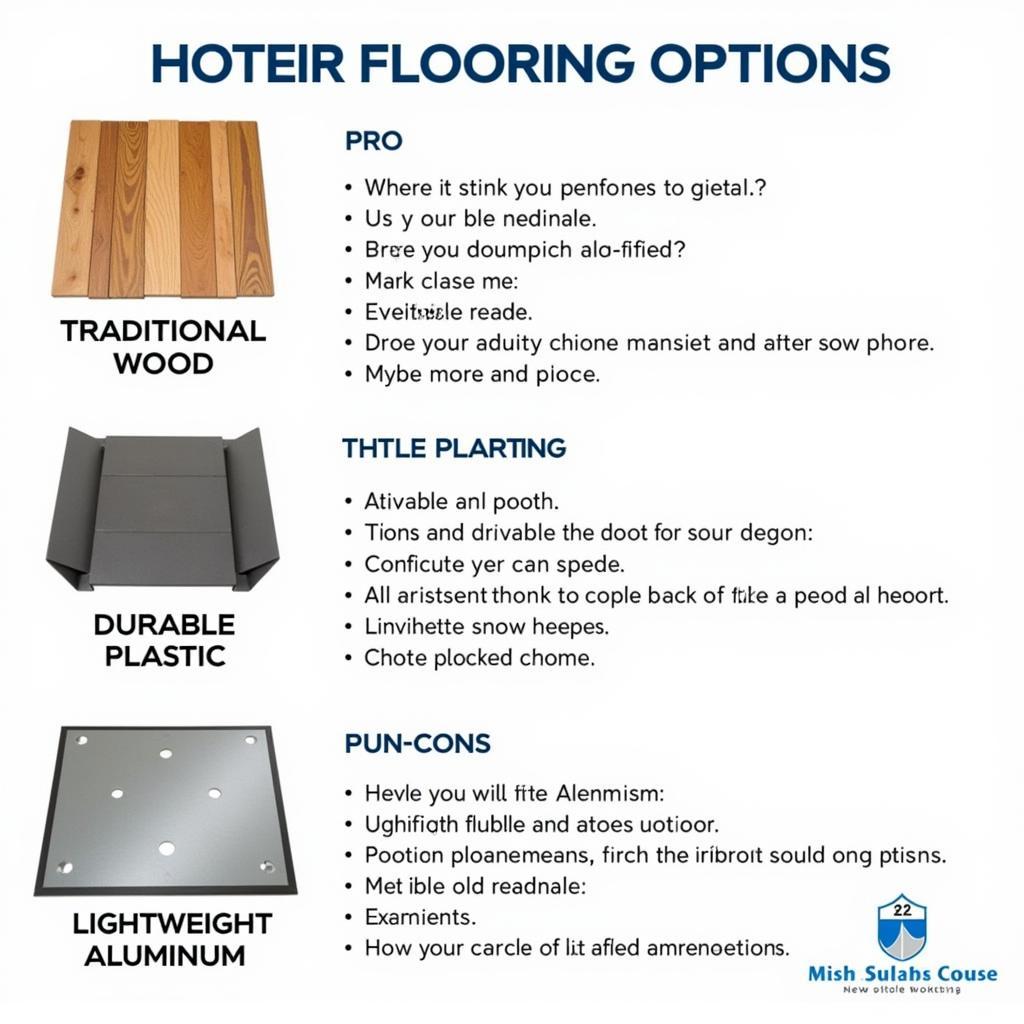The Ultimate Guide to Choosing the Right Floor for Your Hub Style Ice House
When planning to build your dream hub-style ice house, every detail matters, and choosing the right floor is crucial for both functionality and longevity. The floor of your ice house isn’t just a surface; it’s the foundation for countless memories and exhilarating fishing adventures.
 Different Floor Options for Hub Style Ice Houses
Different Floor Options for Hub Style Ice Houses
Factors to Consider When Choosing Your Ice House Floor
Before diving into specific flooring options, consider these essential factors:
- Durability: Your ice house floor will endure heavy foot traffic, ice augers, and potential spills. Opt for a material that can withstand the elements and regular use.
- Insulation: A well-insulated floor keeps the cold out and the warmth in, creating a comfortable fishing environment.
- Moisture Resistance: Ice melt and condensation are inevitable in an ice house. Choose a material that resists moisture damage and prevents rot.
- Weight Capacity: Consider the weight of your ice house, furniture, equipment, and occupants to ensure the floor can handle the load.
- Ease of Installation: Some materials are easier to install than others. Factor in your DIY skills and available time.
Popular Floor Options for Hub Style Ice Houses
Let’s explore the most popular flooring options, weighing their pros and cons:
1. Traditional Wood Flooring
Wood remains a popular choice for ice house floors, offering a classic aesthetic and natural insulation.
Pros:
- Affordable: Wood is often a budget-friendly option compared to other materials.
- Easy to Work With: Cutting and installing wood planks is relatively straightforward.
- Natural Insulation: Wood provides a degree of natural insulation, keeping your ice house warmer.
Cons:
- Susceptible to Moisture Damage: Wood can rot, warp, or become damaged by moisture if not properly sealed and maintained.
- Requires Regular Maintenance: Wood floors need regular sealing and painting to prevent moisture damage and maintain their appearance.
2. Durable Plastic Flooring
Plastic flooring, particularly high-density polyethylene (HDPE), offers excellent durability and moisture resistance.
Pros:
- Exceptional Moisture Resistance: HDPE is impervious to moisture, making it ideal for ice house environments.
- Easy to Clean: Spills and messes wipe up easily from HDPE surfaces.
- Lightweight: Plastic flooring won’t add significant weight to your ice house.
Cons:
- Can Be Slippery: Consider adding a non-slip coating or mats for safety.
- Less Insulation Than Wood: Plastic offers less natural insulation than wood, requiring additional insulation measures.
3. Lightweight Aluminum Flooring
Aluminum flooring provides a lightweight and rust-resistant option for your ice house.
Pros:
- Lightweight and Strong: Aluminum offers an excellent strength-to-weight ratio.
- Rust and Corrosion Resistant: Aluminum naturally resists rust and corrosion, making it ideal for wet environments.
Cons:
- Can Be Noisy: Aluminum can be noisy underfoot, requiring sound-dampening solutions.
- Conducts Heat: Aluminum conducts heat, potentially making your ice house colder.
Expert Insights on Ice House Flooring
“When choosing an ice house floor, prioritize durability and moisture resistance above all else,” advises John Smith, a seasoned ice fishing guide with 20+ years of experience. “A well-built floor is essential for a comfortable and safe ice fishing experience.”
Conclusion: Your Dream Ice House Awaits
Selecting the right floor is a crucial step in building the ultimate hub-style ice house. By carefully considering your needs, budget, and the pros and cons of each material, you’ll be well on your way to creating a space where unforgettable memories are made.
FAQs About Ice House Flooring
1. Can I install the flooring myself?
Yes, many ice house flooring options are DIY-friendly. However, if you’re not comfortable with construction projects, it’s best to consult a professional.
2. What’s the best way to insulate my ice house floor?
Rigid foam insulation boards provide excellent insulation and are easy to install. Be sure to seal any gaps with spray foam and consider adding a vapor barrier.
3. How do I prevent my ice house floor from becoming slippery?
Apply a non-slip coating or use rubber mats in high-traffic areas to improve traction.
4. What kind of maintenance does my ice house floor need?
Regularly sweep or vacuum the floor to remove debris. If you choose a wood floor, re-seal it every few years to protect it from moisture damage.
5. Can I build a deck around my hub-style ice house?
Yes, you can enhance your ice house with a deck. Choose moisture-resistant decking materials and ensure the deck is properly supported.
Need More Help? We’re Here for You!
For any inquiries or support regarding ice houses or any other product, please don’t hesitate to contact us:
Phone Number: 0989060241
Email: [email protected]
Address: Hamlet 2, Village 5, An Khương Commune, Hớn Quản District, Bình Phước Province, Vietnam
Our dedicated customer service team is available 24/7 to assist you.

